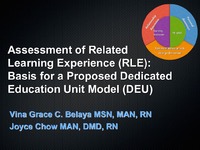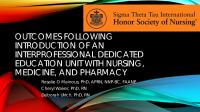| dc.description.abstract | <p>Session presented on Monday, July 27, 2015:</p>
<p>A combination of decreasing clinical sites to train nursing students, critical clinical faculty shortages, and the need to improve clinical learning experience has made colleges look for other ways to provide clinical experiences for their students. Many colleges have implemented Dedicated Education Units (DEU). Compared to a traditional clinical setting where nursing students are under the direct supervision of a nursing faculty, the Dedicated Educated Unit model provides a an innovative learning environment under the combined supervision of an assigned preceptor, nursing faculty, management and other experienced nurses on the unit (Rhodes, Meyers, & Underhill, 2012). Baccalaureate or Master prepared staff nurses on the DEU are the primary teachers of the student, while nursing faculty serve as consultants. The purpose of this study is to examine the benefits of a dedicated education unit model in meeting the needs for a quality clinical experiences. A review of the literature is discussed, including implementation strategies of a dedicated education unit and its benefits to clinical sites and the schools of nursing. This integrative review summarizes currently available evidence on Dedicated Education Units (DEUs) from several articles published in refereed jouRNs which were accessed using search engines such as CINAHL, MEDLINE, and EBSCO. The results from this study would be very beneficial to those educational facilities who are experiencing clinical faculty and site shortages. The results could also be used to enhance clinical experiences and ensure students are obtaining adequate learning experiences. References Benner, P., Sutphen, M., Leonard, V., & Day, L. (2010). Educating nurses: A call for radical transformation. San Francisco, CA: Jossey-Bass Casey, M., Hale, J., Jamieson, I., Sims, D., Whittle, R., & Kilkenny, T. (2008). Dedicated education units -- a new way of supporting clinical learning. Kai Tiaki Nursing New Zealand, 14(11), 24-25. Ferguson, L., & Day, R. A. (2005). Evidence-based nursing education: Myth or reality? JouRN of Nursing Education, 44(3), 107-115 Hodges, H. F. (2011). Preparing new nurses with complexity science and problem-based learning. JouRN of Nursing Education, 50(1), 7-13. Lodico, M. G., Spaulding, D. T., & Voegtle, K. H. (2010). Methods in educational research: From theory to practice (2nd ed.). San Francisco, CA: Jossey-Bass. MacIntyre, R., Murray, T., Teel, C., & Karshmer, J. (2009). Five recommendations for prelicensure clinical nursing education. JouRN Of Nursing Education, 48(8), 447-453. National league for Nursing. (2003). Innovations in nursing education: A call to reform. Retrieved from www.nln.otg/aboutnln/positionstatements/innovation082203.pdf Phillips, J. M., & Vinten, S. A. (2010). Why clinical nurse educators adopt innovative teaching strategies: A pilot study. Nursing Education Perspectives, 31(4), 226-229. Rhodes, M. L., Meyers, C. C., Underhill, M. L. (2012). Evaluation outcomes of a Dedicated Education Unit in a baccalaureate nursing program. JouRN of Professional Nursing, 2012, 28, 4, 223-230</p> | en |





